Hey all, I hope you’re all doing well. This has been a wild month for all of us, I’m sure. For my part, not a whole lot of day-to-day has changed. I already work from home, so I’ve been meeting deadlines as usual (though I’m taking on fewer things right now as I still adjust to being a work from home mom). My husband is still on paternity leave until April 13, but it’s looking like he’s going to be working from home after that point, as well. We were already largely staying at home since Sev can’t get her flu shot until she’s 6 months old, but now the flu has been completely overshadowed by COVID-19. And of course, we can’t have any visitors now. My mother had been coming up from Connecticut weekly to spend the day with us, and we really miss her presence.
It almost feels silly to do a reading round-up, a little unimportant in the grand scheme of things. But I think a lot of people are trying to find ways to spend their time at home, so hopefully some reading recommendations won’t be amiss. And besides, sometimes it’s helpful for our mental health to try to keep some sense of normalcy in the face of adversity.
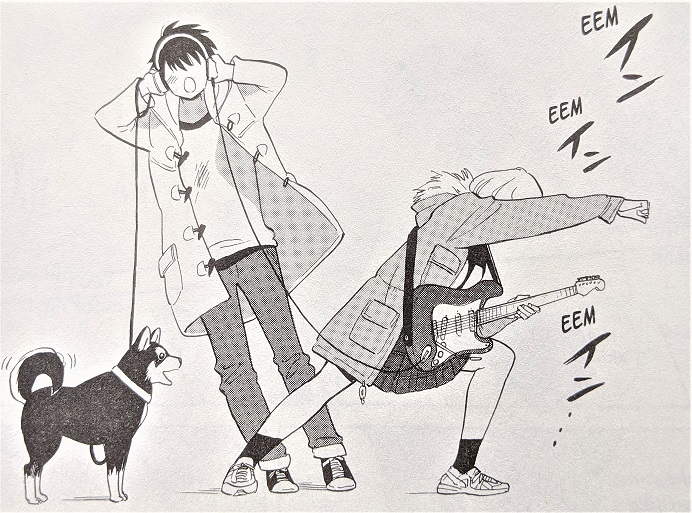
The Golden Sheep, Volume 1, by Kaori Ozaki — published by Vertical Comics
This is one I missed when it initially came out and ended up borrowing from the library before we all had to avoid public spaces. I had read and loved Kaori Ozaki’s The Gods Lie, so I was eager to read something else of her’s. In The Golden Sheep, protagonist Tsugu Miikura is moving back to her hometown after having moved away in elementary school. She is eager to reunite with her three childhood friends, expecting that nothing would have changed between them in the intervening years. Unfortunately, she finds that tensions in the group are high, and her dream of coming home to something familiar winds up backfiring. Ozaki’s got an incredible ability to pepper her high drama stories with humor and gentleness. The simplicity of her character designs does not hinder their expressiveness; indeed, her characters are full of emotion. I may have to wait until I can go back to the library to read the second volume, but I’m looking forward to it!
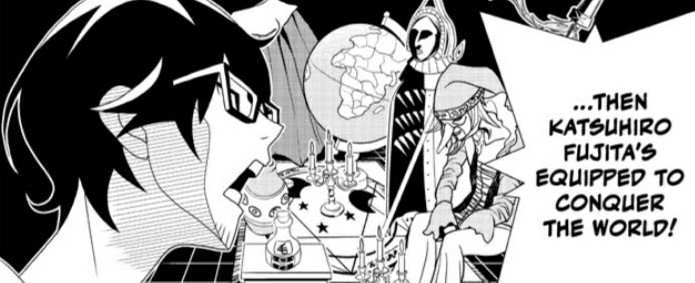
Kakushigoto: My Dad’s Secret Ambition, Volume 1, by Kouji Kumeta — published by Kodansha Comics, available digitally
I honestly wasn’t expecting to like this manga. I almost didn’t read it at all, in fact. At first glance, it can seem like one of those series where a father has a questionable relationship with his daughter. In this case, father Kakushi Goto is a mangaka who specializes in “dirty” manga. He is desperately trying to keep his career a secret from his little daughter, Hime. He wants to protect her from the embarrassment of having a father in a sleazy line of work, not realizing that everyone around him respects him and loves his work. In pursuit of keeping his secret, Kakushi gets into a lot of weird and humorous situations. But I was most struck by the fact that this really does seem to be a sweet story about a father who wants what’s best for his daughter, and a daughter who loves and supports her father no matter what. I personally also like the inside baseball stuff about the manga industry. My favorite part was the frankly absurd cameo by Kazuhiro Fujita, creator of Ushio & Tora and The Ghost and the Lady. Really fun, and available digitally — so good quarantine reading!
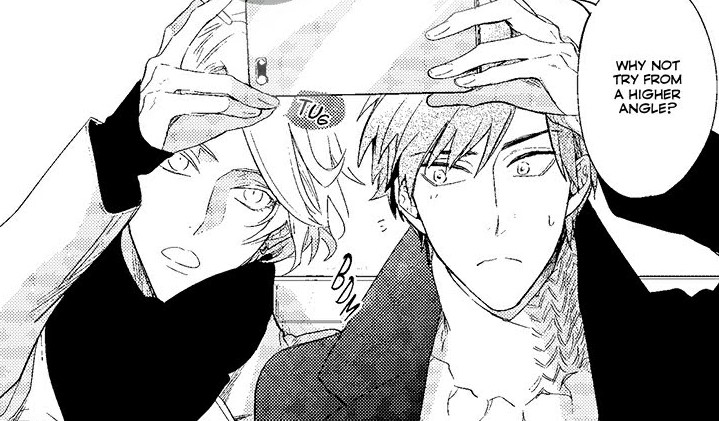
Therapy Game, Volume 1, by Meguru Hinohara — published by VIZ Media’s SuBLime imprint, available June 9, 2020
This is another manga I liked more than I anticipated! This is the sequel series to Meguru Hinohara’s oneshot Secret XXX (coming out April 14), which I also had a review copy of and thought was reasonably cute. But Therapy Game has character types I like better: the aloof, beautiful, and very gay guy who is actually very sensitive, and the gentle, heartbroken guy who is trying to sort out his feelings. The story focuses on the brothers of the main characters from Secret XXX, Shizuma and Minato. Shizuma had been drinking his sorrows away in a gay bar after getting dumped by his girlfriend, and Minato happened to listen to him and then take him to a hotel room to sleep off the booze. Shizuma, allegedly straight and definitely wasted, ends up giving Minato an extremely memorable evening — which Shizuma completely forgets by morning. Minato decides that he’s going to get revenge by seducing Shizuma and then dumping him, but of course…real feelings crop up unexpectedly! It’s definitely a dramatic, sappy manga, and it leaves off on a bit of a cliffhanger in terms of the guys’ relationship. But I often feel like I have to wade through a lot of middling to bad BL, and this one stood out in character and artwork for me. You don’t have to have read Secret XXX to understand what’s going on, but a couple references might be lost on you. (I didn’t realize it was a sequel going in, only realizing it after seeing characters from the other manga.) Needless to say, this is absolutely a mature manga for readers 18 years old and over. There’s not a lot of explicit sex, but it’s definitely there, so reader beware!
And that’s March! I hope that by the end of April, we’ll all have some better news about COVID-19. In the meantime, I have to spend my birthday and Easter both at home away from family and friends, and that’s hard — but it’s necessary, and I know we’re all giving up a lot to make sure that we flatten the curve! Please be safe and responsible, and if you can, take advantage of any free time to catch up on reading, or take up a hobby, or just simply rest. And wash your hands! ;3
review
November Favorites
Well, I realize we’re already nearly halfway through December, but I promised monthly favorites lists, and by golly I’m going to get one out to you! I had considered rolling November and December together, but I have a brief moment of respite between all the end-of-the-year deadlines, so I thought I’d take a few to get this done.
Like many people, my life gets increasingly hectic starting in October and ending…well, never, but at least settling down somewhat by January. November saw me baby showered, nursery tidying, having my blood pressure monitored at the hospital, celebrating Thanksgiving with my family, attending a birthing class, and just generally becoming more worn down as I entered the third trimester. Even more has happened since November, but I’ll leave that to next month’s favorites list (which might be the last one for a while).
And of course, much of my reading these days comes down to what is necessary for work, not always what is foremost on my personal interest list. I’ve gotten much more reading done this month already — somehow, being extra busy means finding creative ways to get other things done sometimes! But I’m getting ahead of myself. Let’s take a look at two stand-out comics that I read in November!
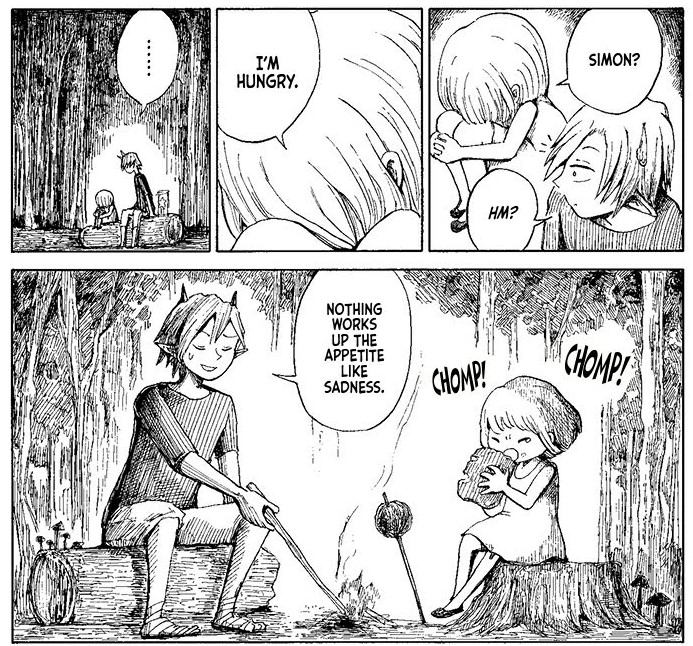
Nicola Traveling Around the Demons’ World, Volume 1, by Asaya Miyanaga — published by Seven Seas Entertainment
I wrote a full review of this manga over at Comics Beat, but I couldn’t help but talk it up again. I have a hard time finding manga that I can unreservedly recommend for all ages, but Nicola is one of those rare books that I can hand to any kid confident that it will be fun, appropriate, and suitably weird. Obviously, parents who keenly object to sympathetic depictions of Hell might be put off, but on the whole, this is a story about a sweet little witch girl who is scooped up by a traveling Devil merchant on her quest through the demon world. She has only one magical ability: she can make a flower appear. She is proud of this, but sad that she can’t seem to get any further in her magic abilities — except that she’s had a couple big breakthroughs that she can’t replicate. The premise is fun, the characters are charming, and the sketchy quality of the artwork (printed in brown ink in the physical version of the manga) is unique and rich. I was pleased that my initial review on Comics Beat led my cousin to consider it for his daughter’s Christmas gift; it’s an excellent pick for the kid who delights in the weird but isn’t really keen on being outright scared.

Baby: A Soppy Story, by Philippa Rice — published by Andrews McMeel, out January 14, 2020
When I announced my pregnancy, I put out a call for comics recommendations about pregnancy, childbirth, and parenting. The options, especially for pregnancy narratives, were very slim, and I was beginning to get disheartened. But it looks like there are a number of autobiographical pregnancy comics coming early next year, right around the time my own baby will be born! I was lucky to be able to grab an early copy of Philippa Rice’s Baby, which is both gentle and honest in its depiction of Rice’s experience with her first pregnancy. (Judging by her Instagram feed, it looks like she’s pregnant again — with twins!) I’ve read a little bit of her other work (like Sister BFFs), and I’m always struck by how similar our experiences are…and only slightly because she draws herself a little bit like how I look/used to look, all bobbed hair and red/black/white clothing, haha. This little book had me laughing, nodding, and sighing along with how relatable it is to my own pregnancy experience, and it really got me excited about bringing this new little life into the world. Her work is very sweet, so I definitely recommend looking back through her previous works while you wait for this book to come out in January!
So this month was something for the kiddos and something for moms and moms-to-be, it looks like! Next week, I’m expecting my in-laws in town for the holidays, so there’s a chance that the December Favorites will also be delayed. I am pretty keen on getting it done, however, since who knows how much I’ll be able to do once I have a tiny baby attached to me at all hours of the day. Until then, I hope everyone has an enjoyable holiday season full of warmth, tasty meals, family and/or friends, and excitement for the year ahead!
October Favorites
October is over! Can you believe it — my favorite month zipped by so quickly, just like it does every year. I love Halloween but also always get a little sad when it gets close because that means the spookiest month of the year will soon be done. But no matter, November is also lovely, and the holidays are coming up fast. I do enjoy spending the cold winter months with family — and this year we’ll be inviting a new member come late January or early February, so there’s a lot to look forward to!
This year, I helped to organize and run the Massachusetts Independent Comics Expo, better known as MICE. Because it was my first time helping, and because I was not as mobile as usual, I felt like I did more observing and learning than anything else. But I had a wonderful time, and I was even able to pick up a couple zines on pregnancy and motherhood! I’m slowly chipping away at my goal of writing about what I’m affectionately referring to as “mom comics.”
Other than MICE and Halloween, it’s been business as usual. I read a couple lovely things this month that I want to share with you, both very much in the spirit of the spooky season!

The Wize Wize Beasts of the Wizarding Wizdoms, by Nagabe — published by Seven Seas Entertainment
I actually did a full review of this manga for Comics Beat (along with a review of Cats of the Louvre), but I just wanted to reiterate how much I enjoyed it since I don’t write those reviews in the first person, and these posts on my blog are more about my personal opinions! Wize Wize Beasts is, in a word, great. It is fluffy BL romances set in a magical wizarding world full of humanoid animals. It plays with some BL and romance tropes that aren’t my favorite (like a student-teacher mutual attraction, though it doesn’t get taken too far), but it’s mostly just fun. I keep using the word “indulgent” to describe it, because it’s not pretending to be anything other than pure entertainment. And, as always, Nagabe’s artwork is wonderful — dark and whimsical, with deft character designs.

The Twilight Man: Rod Serling and the Birth of Television, by Koren Shadmi — published by Life Drawn (Humanoids)
Oh, Rod Serling. I had been looking forward to reading this advanced copy I had for a while, and I finally just went for it. No regrets. I’m a huge fan of The Twilight Zone and of Rod Serling as a writer and a person, so this biographical comic was always going to be my catnip. It is thoroughly and lovingly researched, and follows Serling from his days serving in World War II all the way through post-Twilight Zone and to his all-too-early death. Koren Shadmi chose to depict the entire book in black and white/grayscale, which I really appreciate. As a manga reader, I often prefer black and white comics because I like to see the use of texture and shading really pop (which is possible in color comics, of course, but less common). In this case, it also lends that old-TV look and feel, giving us the Rod Serling we all recognize from our small screen. I also love the way Shadmi used the framing of The Twilight Zone to pull a bit of a twist on the reader — but I don’t want to give anything away! Definitely give it a read if you’re interested in the show, the man, or in the television industry in the 50s and 60s. There’s a lot of really fascinating information about how writers, producers, and studios operated at the time that I think most people wouldn’t know much about otherwise — and a lot of conversation about commercialism, appealing to the “lowest common denominator” of an audience, and being subject to the whims of the censors.
And that’s October’s recommendations! Just two months left this year, and I’m way behind on my Goodreads reading challenge, which isn’t too much of a surprise. We’ll see if I’m able to make it to 250 books (an ambitious goal to be sure) by the end of December. I definitely have some really interesting manga in my to-read pile, so I’m looking forward to having more to share by the end of November. Until then, happy reading!
September Favorites
I’m a little later than usual this month! September was a good month, full of lots and lots of writing work, visiting in-laws, and a trip to New Hampshire for some good New England-y early autumn fun. I continue to grow rounder with each passing day, and the baby has decided to set up a dance studio in my belly.
In manga-related news, I got to cover Skull-Face Bookseller Honda-san and The Way of the Househusband for Comics Beat this month. I did mini-reviews of them here last month, but you can read a more detailed review if you follow the links. I’ve also officially started as one of the hosts of Manga Machinations, and it’s been so much fun. It’s really rewarding to be able to have good, engaging conversations with people about manga. And knowing that others are interested in listening to those conversations and providing their perspective is awesome, too. Aaaaaaand Selling Comics came out! My name and my writing is in a real, printed book! It’s so cool, I’m still kind of in shock.
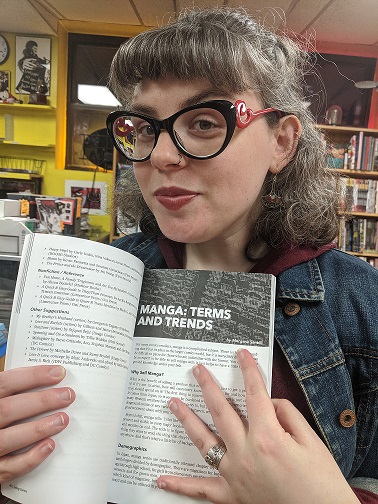
In terms of reading this month…unfortunately, a lot of it was for work or the podcast (and right now I’m reading a long-anticipated novel), so I only have one pick for you all. But it’s a real good one!
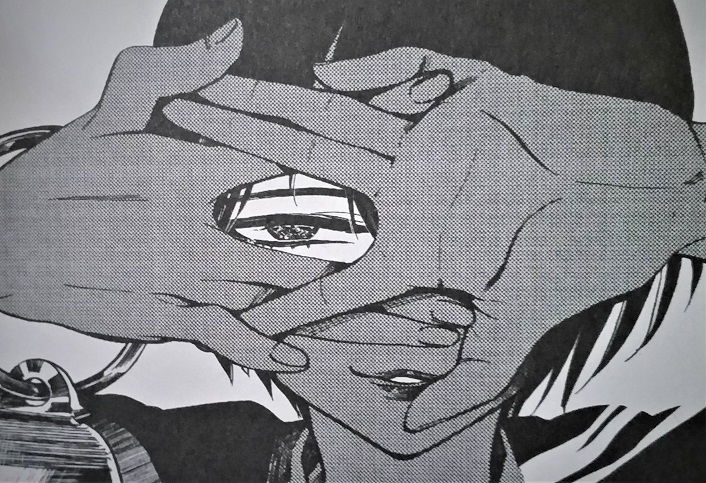
Phantom Tales of the Night, Volume 1, by Matsuri — published by Yen Press
Some of you may remember my love letter to Matsuri Akino’s Pet Shop of Horrors, one of my favorite manga of all time. My exposure to that series set in motion an obsession of mine; namely, the episodic morality play that utilizes an unreliable or amoral shop owner or service provider involved in the supernatural to mete out cosmic justice — or just sate his own desires — all wrapped up in a pretty, artistic package. Phantom Tales of the Night falls neatly into that description, with a mysterious innkeeper who trades protection, information, or a room for his clients’ secrets. And like every good nameless creepy innkeeper, his origins and history appear to be less than savory, though the first volume only gives us a glimpse at his arcane abilities. I’m such a sucker for stuff like this. It’s kind of pulpy, kind of queerbait-y, definitely pure, shameless entertainment. And while nothing will ever quite move me like the artwork in Pet Shop of Horrors, this series’s creator Matsuri (a different Matsuri!) has a lovely style that lends itself equally to beauty and body horror and weirdness. Again, totally my kind of manga.
And so, I end September and begin October on a decidedly spooky note. Historically, October has been an extremely busy time for me, and this year is no exception. I have volunteered to help with the Massachusetts Independent Comics Expo (MICE) this year, which is one of my absolute favorite local shows. If you’re around Boston the weekend of October 19-20, you should totally check it out and say hi! In between that, celebrating the season, and getting my normal work done, I’m going to try my best to read more. I’m hopefully going to also talk a bit about my horror manga recommendations! It’s something I always want to do but never quite get around to, and I’d really like to make the time to write about one of my favorite genres of manga.
Until then, happy reading!
July Favorites
It’s been another bustling, busy month, but I made good on my promise and read more comics in July! I’m still more behind on my reading than I’d like to be, but it feels good to get back into some kind of routine (even if I have been doing all my work from our new couch instead of at my desk…).
At the top of the month, I started recording a four-part series with the wonderful gentlemen of the Manga Machinations podcast, a retrospective of Akiko Higashimura’s EISNER-AWARD WINNING Tokyo Tarareba Girls. Long-time readers and folks who follow me on Twitter will know that this is one of my absolute favorite modern series. I wrote about my feelings on the first volume ages ago, and those feelings have multiplied and intensified with each passing volume. By the time this post goes up, we’ll be three-quarters of the way through the retrospective. I hope that those of you who have had a chance to read the series will listen to our discussion of it and give us some feedback on your feelings about Higashimura’s love letter to 30-something women and the problems they face. It’s thrilling that I was able to talk about this series in the midst of its Eisner victory. Deb Aoki asked for some of my thoughts on the win and its potential affect on sales for her Answerman column over on Anime News Network, as well. I can’t reiterate enough how every manga fan should follow Deb on Twitter if they want all the latest news from cons and publishers. She’s a force of nature with her Tweeting skills!
I’ve also continued my work for The Comics Beat with reviews for Beastars volume 1, Junji Ito’s Smashed anthology, and the first two volumes of Satoko and Nada. Writing long-form manga reviews is my favorite job right now, hands down. It’s nice to be able to take the skills I utilized recommending manga to customers through working at Comicopia and translate that into recommending manga to readers all over the world. Since leaving the shop, I had been feeling a little isolated from the comics community, but writing for The Beat has helped me reaffirm my place within it and remind me that the work I do is worthwhile and (hopefully) helpful to readers.
So a lot is happening for me these days, and I’m hoping to have even more good news for you next month. But for now, it’s time to talk about what you all came to read — my favorite comics that I read in July. Some of these will likely be given the full Comics Beat review treatment in the near future, but I wanted to write about them a bit in a space where I can let my personal bias really shine through. :3

Popocomi, by various — published by Eriko Obayashi of Books and Gallery POPOTAME
I bought this wonderful anthology at TCAF and finally, finally sat down to read it. Organized by the Japanese comic shop POPOTAME, this collection features works by “underground” Japanese mangaka — something readers in the West rarely get to see. This collection runs the gamut from more straightforward short narratives to surreal or nonsensical offerings. It certainly won’t be everyone’s cup of tea, but I was really impressed with the variety and the skill on display. I was especially fond of Ikumi Nakada‘s melancholy “In a Worm-Eaten Town” and Maiko Dake‘s bubbly “FROM the BOOK SHOP.” They’re very different little glimpses into the lives of a couple of young women, but they both struck me with their ability to convey tone and emotion through the expressiveness (or lack thereof) of their characters. This collection was created in collaboration with TCAF and translated by the incomparable Jocelyne Allen, who has translated scores of my favorite books, provided interpretations for Junji Ito during TCAF, and who is a lot of fun to hang out with. The book was enthusiastically sold to me by one of the artists (whose name I unfortunately didn’t catch!), and came with a sweet little map of bookshops in Ikebukuro-Mejiro. The whole experience of buying and reading this book was unique, and it reminded me of the importance of connecting bookshops and artists with their products — something I believe in very strongly. Support your local bookstores! Support your local artists! Remember that a lot of love and care goes into putting together the works you love.
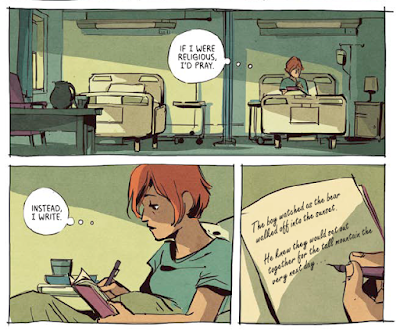
Waves, by Ingrid Chabbert & Carole Maurel — published by BOOM! Studios
I’m going to be completely honest — I sobbed through this book. The protagonist is pregnant, and the reader is made to believe this is not her first pregnancy, but that her other attempts thus far have failed. She and her wife are deeply invested in having a child, but because the protagonist’s condition is so tenuous, she is made to stay in the hospital. Unfortunately, things take a turn for the worst and the couple loses their precious son — stillborn. God, I’m starting to tear up just typing this! But the story is not just about losing the baby. It is about how that loss is used to help the protagonist push forward and find hope in a new career of writing books for children. This is an autobiographical comic with gorgeous illustrations by Carole Maurel that utilize color to great success. It’s definitely not a light read, but it is short and extremely affecting. I thought it was brilliant, even if I had to read a lot of it through blurred vision.
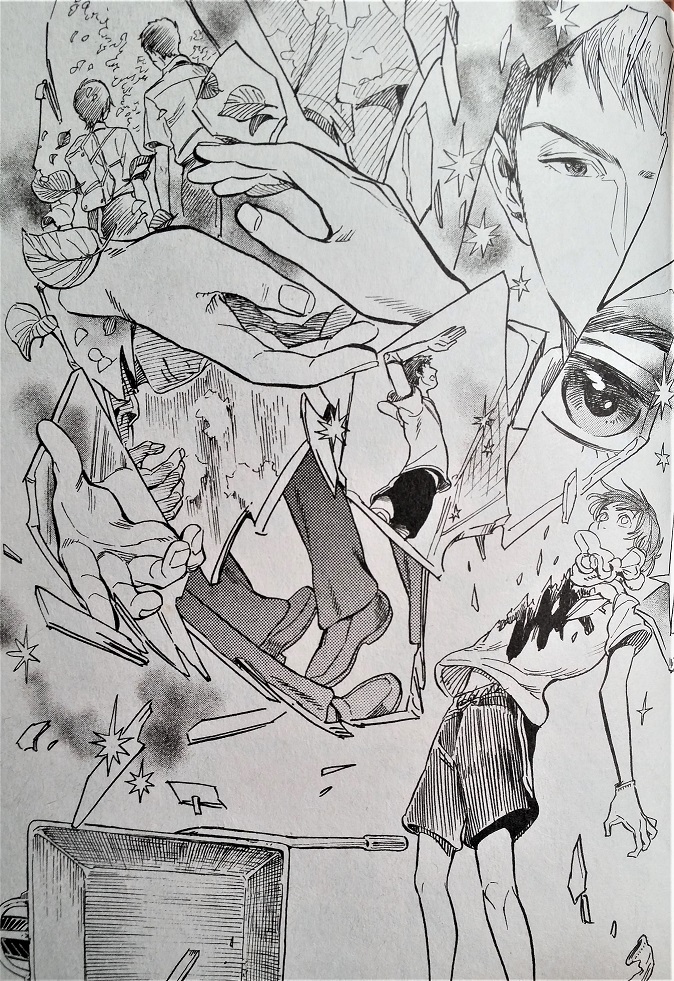
Our Dreams At Dusk, by Yuhki Kamatani — published by Seven Seas Entertainment
I have been SO excited for this release for so long, and I finally got my hands on a copy through the library. It is a little different from what I anticipated, but I’m not at all disappointed in it; rather, I think it’s great, and I can’t wait to check out the next volume which just recently came out. Protagonist Tasuku Kaname is struggling at school. Not with bad grades, but with being the new kid and being singled out for being gay. Of course, he didn’t tell anyone that he was gay, and he vehemently denies it, but the teasing comes anyway, to the point where Tasuku’s conflicting feelings nearly lead him to make a fatal decision. Luckily, he is distracted by a woman he sees in the distance who appears to be jumping to her death as well, and when he runs to see what became of her, he is confronted with her, whole and hale, and referred to by everyone in the drop-in center he found her in as “Someone-san.” Through this strange encounter, Tasuku meets others who are queer, and he is able to begin confronting his own fears about his sexuality and what it means for his life and his relationships. I find it deeply gratifying to have a fictional LGBTQ+ manga written by a non-binary creator and depicting a supportive queer network. A lot of the genuine queer works we’ve seen coming Stateside are autobiographical, and while their messages are so important, it is nice to see the field open up to fiction that isn’t relegated to BL or yuri — both of which are great in their own way, but which seldom reflect lived experiences or common concerns, especially amongst queer youth. Kamatani is know for their other manga series, Nabari no Ou, and I’m hoping that the name recognition might help get this manga into the hands of those who need it most — though my guess is that it’s already doing quite well based on the force of its subject matter alone. The importance of the story and characters aside, Kamatani’s artwork is gorgeous — fluid and expressive, with a boldness that I wasn’t expecting based on the dreamy cover designs.
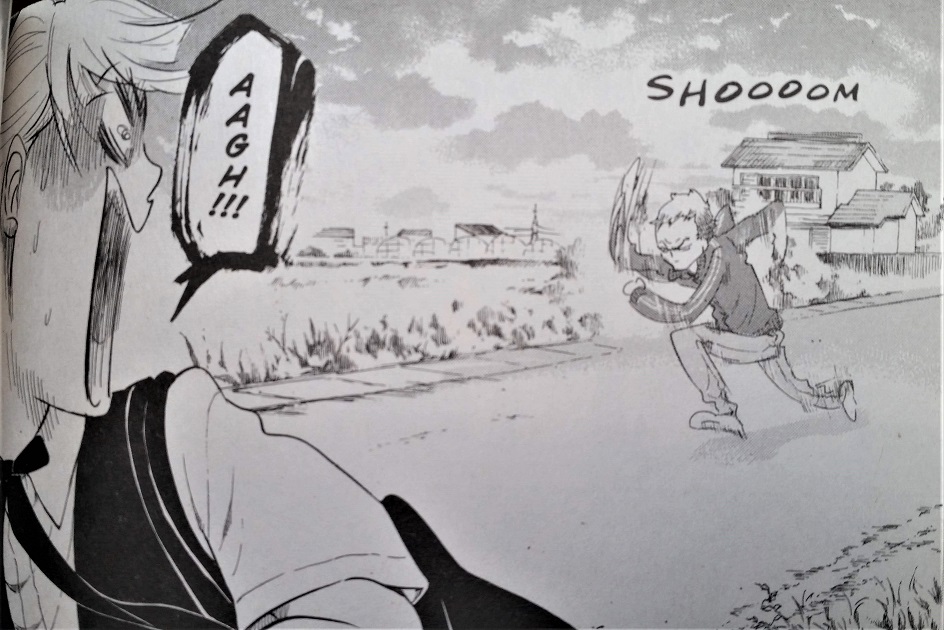
Blank Canvas, by Akiko Higashimura — published by Seven Seas Entertainment
This month I finished reading Tokyo Tarareba Girls and then immediately delved straight into Higashimura’s autobiographical work Blank Canvas, where she details her teenage experience of attending art classes outside of school to help boost her portfolio for college, and her relationship with an old, ornery art teacher who helped her improve immensely. I love Higashimura’s no-holds-barred, unflattering depiction of herself at that age: cocky, under-motivated, and underneath everything, deeply uncertain. This helps to shed new light on Higashimura’s many successes as a mangaka, reminding readers that while there might be something about her that is innately talented, it took years and years of work and drilling to become the master she is today. I could have used this manga as a self-assured teen, if only to light a fire under my butt to work harder at my dreams and to seek out the guidance I didn’t really think I needed. I’m still a little too cocksure sometimes, so it’s amazing to see someone I respect as much as Higashimura humble herself for her audience in this way. I’m not sure I’d have the same confidence if I were her, but she has absolutely, 100% earned it. And besides, she seems like the kind of teen it would have been fun to be friends with.

Classmates, by Asumiko Nakamura — published by Seven Seas Entertainment
There was a time, not too long ago, where I was very skeptical of Seven Seas’s output. They published a lot of works that were not for me in the extreme, with plenty of fanservice and an uncomfortable blurry line between what constituted age-appropriate content and what did not. And yet here I am today, promoting three of their recent manga with nothing but my highest accolades. At some point around the time they published My Lesbian Experience With Loneliness, Seven Seas took a deep dive into queer stories and have really set the standard for what types of manga readers are really scrambling for. Among those is one of my all-time favorite manga, Classmates. DMP had already owned this license, for digital distribution only, so I had read it a couple years back. I was struck then by a few things: the genuine sweetness of the story itself, and Asumiko Nakamura’s bizarre, stretchy, almost uncomfortable art style (which I adore). In my twenty-ish years of manga reading, I’ve read a lot of BL. A vast majority of it has been purely horny trash, stuff I didn’t particularly even like but felt compelled to read just to see if I could find the hidden gems. And the hidden gems are there, but you have to wade through scores of tropes: near-rape or rape scenes, coercion, incest, abuse, student-teacher relationships…basically, the tawdry, the inappropriate, and the obscene. But sometimes a manga like Classmates comes along — a sweet story about two teenage boys who fall in love and stumble through a predictable teenage relationship without too much meddling from the outside. And it’s a happy manga, one that brightens your day with its effortless charm and its delightfully wacky artwork. Nakamura’s long-limbed, long-lashed, almost alien-looking characters seem suited to eroguro works or philosophical stories — and she’s done things like that, too (I’m thinking specifically of Utsubora) — but somehow her distinct flair makes the characters’ expressions of amorousness, embarrassment, and teenage hilarity all the more effective. I’m so glad that this series has gotten the print treatment, and I hope that it draws in many, many new readers!
Phew! A really long one this month to make up for June’s scarcity. It’s nice to be back on a roll with reading — let’s hope I can keep it up for a while. Until next month, I wish you all happy reading!
April Favorites
Every month, I get the itch to write this segment about halfway through, thus defeating the point of having a monthly round-up! I get too excited to talk about what I’ve just read, and I read a lot of good stuff in April.
Actually, a lot of stuff in general happened in April. I turned 29 on the 4th, so here’s to the last year of my 20s! My husband and I are in the midst of apartment hunting, which is always chaotic, especially here in the Boston area. And Anime Boston was last weekend! Even though I don’t technically work at Comicopia anymore, I helped with the ordering and was there on the floor from set up on Thursday to break down on Sunday. It was a really great show, and I’m glad I was able to be a part of it. Selling at conventions is my favorite kind of retail, because everyone is just so excited to be there and see what you’ve got and talk to you about it. And all the con-goers are so creative — I saw so many excellent costumes! Oh, and my very first post for Anime Feminist went up this week, as well: a spotlight on amazing artist and mangaka Junko Mizuno.
As May approaches, I’m getting ready to head over to the Toronto Comic Arts Festival (TCAF) for the first time, and I’m super excited. Between that and moving, May is going to be intense — but we’re not there yet. For now, I want to reflect on all the good stuff I read in April! And it’s actually all relatively new stuff this month, a sure change for me.
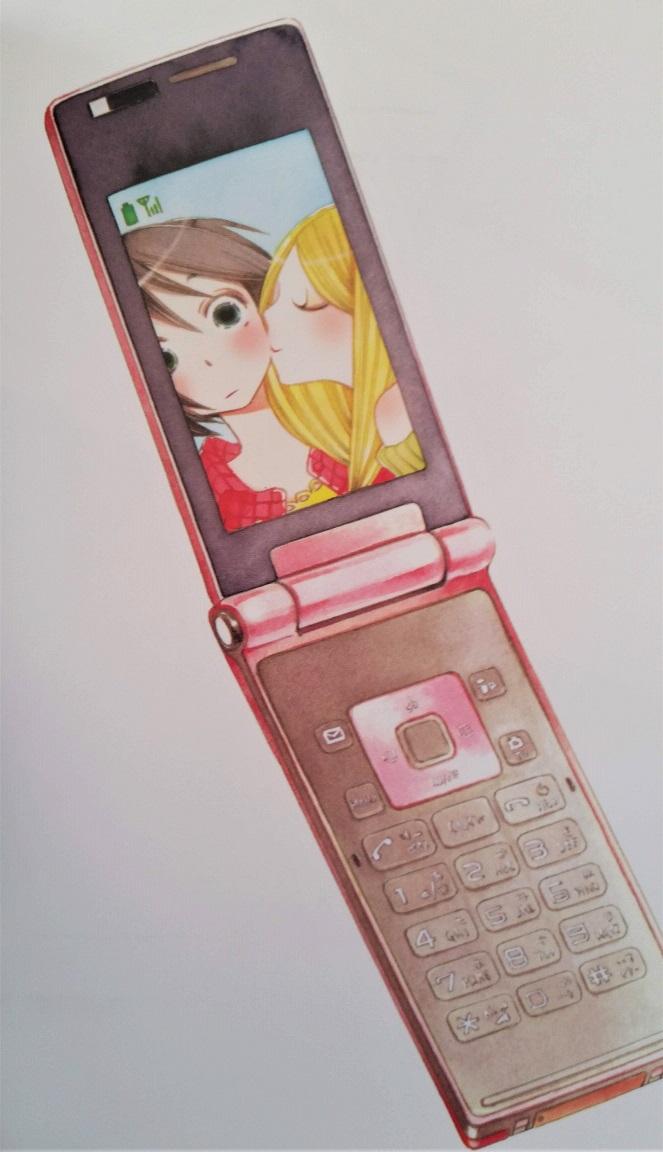
Maiden Railways, by Asumiko Nakamura — published by Denpa
This is the first of Denpa’s offerings that I’ve gotten a chance to read, and it’s the one I was most looking forward to. I love Asumiko Nakamura. Her art is so strange, both adorable and almost uncomfortable with all its sharp angles and long limbs. This volume is an anthology of railway-themed romances. It is simple and straightforward in many ways, but as with all of Nakamura’s work, it sets a very distinct tone, in this case of hope and longing and compassion. It’s a really lovely little collection with some lesbian themes neatly tucked into it with no fuss. Between this and Seven Seas’s upcoming print version of Classmates coming out soon, I am thrilled that more readers have access to Nakamura’s work.

Bloom, by Kevin Panetta and Savanna Ganucheau — published by FirstSecond
I had to wait for this book from the library for months, and I absolutely understand why — it’s absurdly charming. Ari’s dream is to move to the city with his band, but he can’t seem to escape his responsibilities at his family’s bakery. Hector, a culinary school student, has come to town to pack up his deceased grandmother’s home. Ari hires Hector to help in the bakery, in the hopes that by replacing himself, he will leave his parents no room to argue about his leaving home. But over the course of the summer, Ari and Hector grow close, and they have to make some big decisions about where their lives are headed, and whether those lives include each other. This book was so unbearably sweet, and so beautifully illustrated. Savanna Ganucheau does an excellent job of showing everyday examples of sexiness — nothing exploitative, but the little kinds of things that a person appreciates in their partner, like how they look when they’re focused, or how they move when they’re excited. With a cast diverse in both ethnic background and body type, and a strong, happy queer narrative, this is an incredibly delightful read for teens and up.
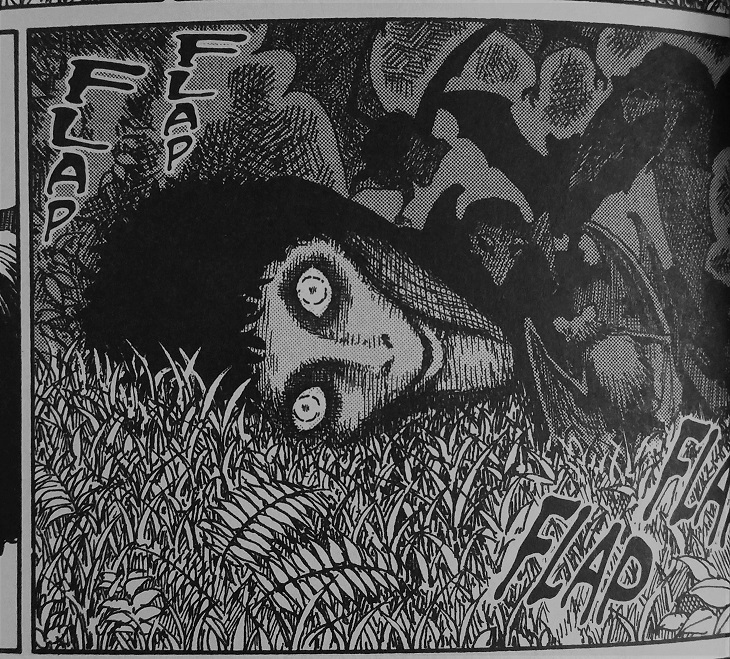
Smashed, by Junji Ito — published by VIZ Media
It’s no secret that I’m a HUGE Junji Ito fan. (That’s part of the reason I’m so excited about TCAF!) I never know what to expect with each new anthology: Will I be scared? Will I laugh? Will I feel like I just watched a particularly poignant episode of The Twilight Zone? For me, this collection had a lot of humor in it, and that is perhaps one of my favorite things about Ito’s work. There is a very fine line between comedy and horror, and no one loves to hop back and forth across that line as much as Ito. I think my favorites in this collection were “Bloodsucking Darkness” (because I love bats), “Soichi’s Beloved Pet” (because I love cats), and “Library Vision” (because I love books). The linked Soichi stories never fail to be silly fun, and as usual Ito’s artwork throughout the whole anthology is gorgeous and detailed. Truly, he is a master of horror, and all other kinds of base human emotions.
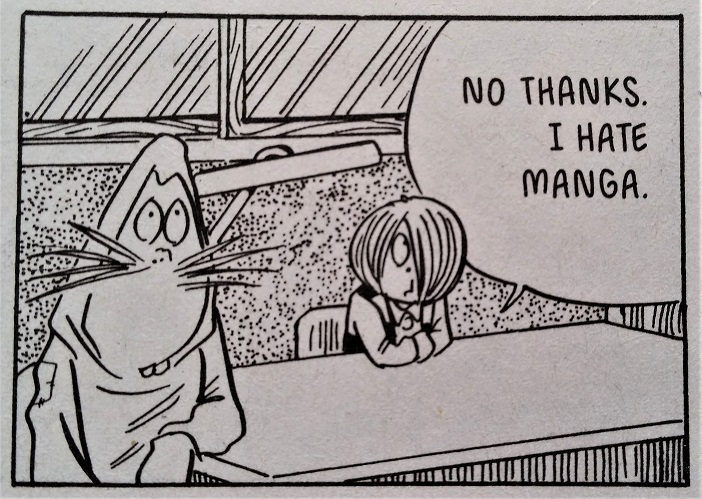
Kitaro’s Yokai Battles, by Shigeru Mizuki — published by Drawn & Quarterly
It’s been so long since there was another installment of Kitaro, and I was thrilled when I was alerted to this making its way into my pull at Comicopia. Who on this earth doesn’t love adorable, weird, childish monsters with potty humor? Only boring people, that’s who! In this collection, I was particularly fond of the “Oboro Guruma” chapter, in which Shigeru Mizuki has inserted himself as a major character, plagued by yokai who are taking over his home as their base of operations. As usual, Mizuki’s cartoony characters sit atop his lush and gorgeous backgrounds seamlessly, and the oft-times odd solutions to yokai-related problems harken back to simpler times and simpler story-telling mechanics. With each volume comes another installment of translator Zack Davisson’s “History of Kitaro,” which really appeals to my interest in both general world history and manga history specifically. A fun read suitable for just about anyone who appreciates a little dark whimsy in their life.
That’s going to do it for this month! I made the conscious decision not to include the sixth volume of Tokyo Tarareba Girls this time around, even though it’s one of my absolute favorite series, because I’ve already written about it in the past, and I anticipate I will talk at great length about it in many forms in the future. I thought I’d spare you all, haha.
I already have a huge pile of comics waiting to be read (don’t I always?), so hopefully I’ll have a nice round-up for May, as well. Happy reading!
March Favorites
It’s finally starting to feel like spring, and I couldn’t be more grateful. It’s so much easier to motivate myself to work when the sun is shining, especially after months and months of frigid winds and gray skies. March is always an odd month, sitting right at the edge of winter and spring, and it often makes me feel unsettled.
After over a month since my sweet kitty Mia’s passing, my husband and I decided we would start the process of looking for new feline companions, specifically hoping to adopt a bonded pair. We absolutely did not expect to adopt on the day we went to the local MSPCA shelter, but of course…the cats had other plans. On March 17th (Saint Gertrude’s Day, the patron saint of cats!), we brought home Zelda and Hilda, a mother-daughter pair of little black cats. They are charming in the extreme, so expect me to gush about them even more as time passes.
On the other end of the spectrum, I’m going to be having my wisdom teeth removed this coming Friday. It’s long overdue, and I’ll be glad once it’s done, but I’m definitely dreading what I’ve heard is a rather painful healing process. But who knows, maybe it’ll afford me more time to read….
Which brings me to the point of this post! Last month I did a round up of my favorite comics reads, and I’m going to go for it again. If I do it twice, it’s a monthly column, right? I actually didn’t read a ton of comics this month, instead favoring some truly indulgent murder mystery audiobooks. But of what I did read, there are a few certain gems that I want to share.
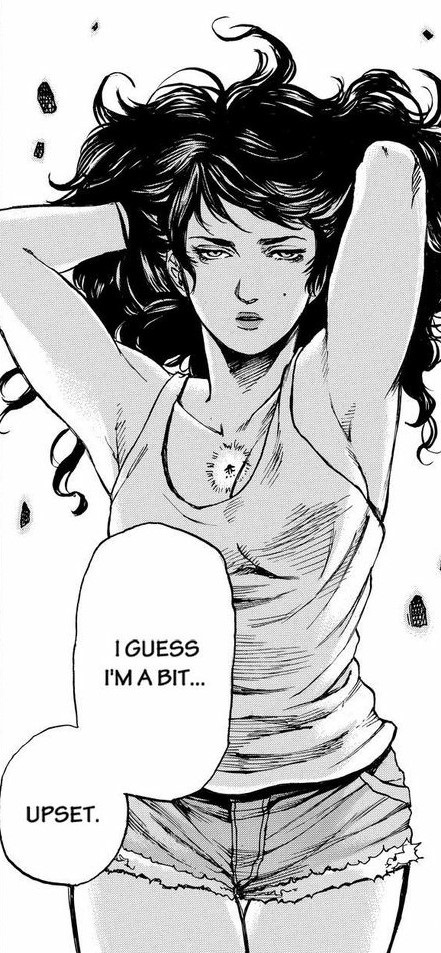
Star Light Woman, by Rie Kanou — available through Crunchyroll
At the start of the month, I decided to sift through the various reading-oriented apps on my tablet to find something new, and I came upon Star Light Woman on Crunchyroll. I was drawn by the image of protagonist Hoshi, rendered in what I think of as an 80s manga style, all puffy hair and cut-off shorts. I’m not sure what I was expecting — maybe a silly, slightly sexy sci-fi romp? And that’s more or less what it is, but somehow I really, really loved it. Hoshi just wants to lead a normal life, but she is the product of an experiment by an alien race to create the perfect weapon to save them from their enemies. She continually has to thwart these aliens while encountering other humans who have undergone similar transformations at their hands. It’s a short little series without much depth, but it’s truly funny and the artwork is stunning. I’m usually very critical of “sexy lady protagonist whose clothes don’t fit properly,” but Hoshi even gets my blood pumping, and I think that her strong, solid frame coupled with her highly moral principles lends a lot to her appeal. She’s like an embodiment of righteous female anger — a subject I’m always eager to see in my fiction!

Memoirs of Amorous Gentlemen, by Moyoco Anno — available through Crunchyroll
I love Moyoco Anno’s work, though I have to admit that this was only the second thing of hers I had ever read. Sakuran was a gorgeous and deeply provocative manga, so when I was scrolling through options on Crunchyroll’s manga app after finishing Star Light Woman, I remembered that I had been meaning to read Memoirs of Amorous Gentlemen for quite some time. I was not at all disappointed, and in fact I read Buffalo 5 Gals immediately afterward, just to get more of Anno’s sassy sex working heroines. But Amorous Gentlemen is special, probably my favorite of Anno’s works thus far. She is incredibly sensitive with sex work while also not over-glamorizing it; Colette and all her co-workers go about their day-to-day business like at any other job, and in many cases care very deeply about their clients. But they also are in close quarters, so they fight and disagree, and sometimes they are all too aware of how they are doomed to this life. The sex scenes are sometimes clinical and sometimes genuinely sexy, and I think that knowing when to evoke which mood in a reader is an incredible skill on Anno’s part. I’m also always going to be a sucker for her very stylized artwork, all angles and frills and fashion.
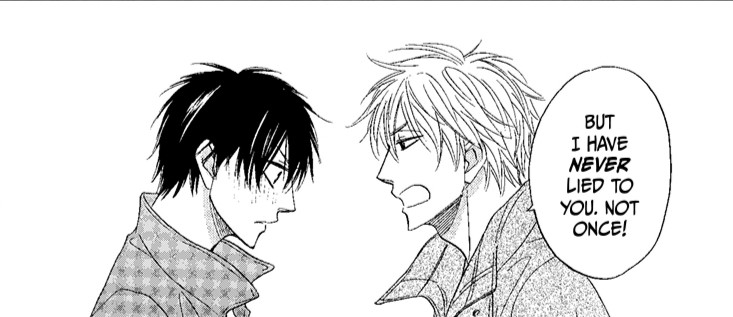
Candy Color Paradox, Volume 1, by Isaku Natsume — published by VIZ Media
The only manga on this month’s list that’s actually new this month, and the only one that has male protagonists! I was able to snag a galley copy of this right before it came out, and I honestly didn’t think it would be anything special. I’ll usually try to read new BL when it comes out, but I’ve been burned so many times with cliched plots or harmful tropes that it’s more a desire to keep up-to-date than an expectation that I’ll find something great. But VIZ’s SuBLime imprint has been knocking it out of the park lately, and I really liked this first volume. Protagonist Satoshi Onoe is a reporter who is proud of his body of work, but one day he is thrown onto a stakeout team with Motoharu Kaburagi, a photographer with a bad attitude whom Onoe believes stole his girlfriend away. The two start off on rough terms, but soon find that they work well together — and they begin to “catch feelings.” You know, that old gem. Honestly, it was cute and fluffy, and I feel like it’s been a long time since I read some straightforward “loathe to like to love” BL manga. The artwork is clean and appealing, with good sense of movement.

Nana, by Ai Yazawa — published by VIZ Media
This month, I decided to embark on a reread of Nana, and I’ve gotten up through volume 7 so far. I honestly don’t remember how much if it I’ve read in the past, so I wanted to make sure I got the full experience. I had watched the anime with my husband many years ago, and it wrecked us both, so coming back to it now, as a woman approaching my thirties instead of a woman barely out of her early 20s, is kind of a weird sensation. I’m farther away from any chance of making rash young adult decisions, but also in a place where I can envy the energy and passion that the characters portray as they lead a dramatic, punk-poverty-chic lifestyle. The series is old now, at least in the timeline of manga, so I don’t feel the need to summarize it, though I may one day write a whole piece about its meaningfulness to me, personally. I remember it didn’t sell great at Comicopia, but it was one of those series that I was adamant about keeping around. Yazawa’s artwork is so strange, with leggy, large-eyed Blythe-doll-esque characters and gorgeous renderings of haute couture of the 2000s, and I’m always enthralled by it. And I genuinely wish there was more work like Nana, work that explored the fraught relationships between female friends who love each other so passionately but don’t have the outlet to express it — an experience that will surely be familiar to many who squashed down their feelings throughout their teenage years for fear of judgment, or just because they didn’t have the tools to recognize those feelings. Society fucks women over, and Yazawa does an incredible job of balancing that message with a lot of genuine sensitivity for two very different women who are desperately reaching for an unobtainable happiness.
So, fluffy BL aside, it seems like I’ve read a bunch of manga about women who are dealing with too many external pressures getting in the way of their desires. That sounds like an appropriate way to have spent Women’s History Month! Honestly, though, my favorite works are often those by women representing the trials of womanhood — not because womanhood is terrible! But because it is cathartic to see your own worries magnified and projected in media sometimes, to see those fears getting played out somewhere safe, allowing you to recognize their validity but also release them in order to achieve your own goals, always knowing that you’re not alone.

The Beautiful & the Damned; Where Violence Meets Aesthetics in Pet Shop of Horrors
Among the extensive list of things I shamelessly love are: the occult detective genre, beautiful men, the monster-of-the-week format, and morality plays. Matsuri Akino’s Pet Shop of Horrors very neatly contains all of these things, and indeed might be the reason I’m so fond of some of them.
For those unfamiliar with this late-90s shojo series, the premise is that in LA’s Chinatown there is a mysterious pet shop whose proprietor, Count D, sells exotic “animals” to anyone who can pay the price. Each animal comes with a specific set of rules, and when those rules aren’t followed to the letter, tragedy inevitably occurs. LAPD officer Leon Orcot is assigned to investigate D and the weird phenomena linked to his shop, but in the process he is drawn into a series of Twilight Zone-esque situations that he cannot explain, let alone report to his superiors.
Right now, I can look at this premise and think to myself, “Yep, this is totally my kind of bullshit.” But when I first picked it up as a young teen, it was because I was drawn to its beautiful cover, where the androgynous D is holding a mermaid, whose back is turned to the viewer. D’s eyes are piercing and almost sad, his fingers long and delicate. I was in love with this man who moved in multiple worlds: the masculine and the feminine, reality and fantasy, beauty and horror.
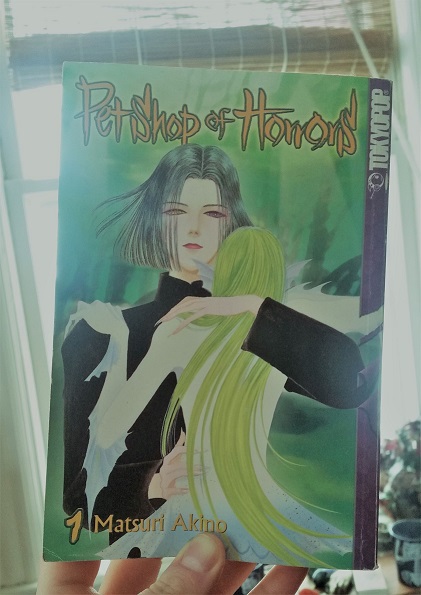
And when I bought and read this first volume, I was shocked. It wasn’t outright scary, necessarily, but it certainly was gory. In the first chapter already was there a horrific scene of evisceration, in and amongst all the trappings of a classic 90s shojo style, preoccupied with luxury and beauty. It was jarring, and it was effective. I discovered then that I didn’t dislike horror like I had previously thought, I just wanted it to be beautiful.
To this day, I find myself critical of scary or violent media that doesn’t also have a keen sense of aesthetics. I don’t necessarily enjoy being frightened; I am a naturally anxious person with vivid and violent dreams who does not react well to heightened suspense in media. I do like dark themes, though, and in recent years I have made it a point to expose myself to films especially that I know I would like if I could just get over my own hang-ups. And by being discerning, I’ve been rewarded with some of the most gorgeous horror and gore I’ve ever seen.
I think beauty and romance are natural companions to horror. All these themes pivot on an axis of drama, of amplified emotions. They all invoke visceral reactions, not logical ones. All my life I’ve surrounded myself with artwork depicting scenes and themes of witchcraft, hauntings, murders, martyrs, and mortality. It seems natural to me that scary things can pull at the same emotions I feel when I recognize something as beautiful.
And all this because way back in 2003, Tokyopop decided to take a chance on something that wasn’t very common in the comics world at the time: horror for girls. There’s plenty of it to be found in the manga world, and now there is more acknowledgement of girls and women reading outside of the romance genre. But it was new for me then, and even now Pet Shop of Horrors remains one of my favorite series, because it presented to me something I hadn’t known I was seeking out. It understood my tastes uniquely; it was able to marry my desire with my rage and prove them to be not disparate but intertwined and equally valid.
In truth, it is a somewhat silly series. It is certainly more fun than profound, but that in and of itself is not a criticism. It is pure, indulgent entertainment, and for me it is certainly laced with a nostalgic love that I will never be able to shake. How many times have I reread and referenced that first volume, gazing awestruck at the lovingly rendered intestines spilling out of a beautiful man’s body? How many times have I giggled at the flirtatious relationship between D and Orcot? How many times have I wished that modern depictions of mermaids were even half as scary as the one Akino has created?
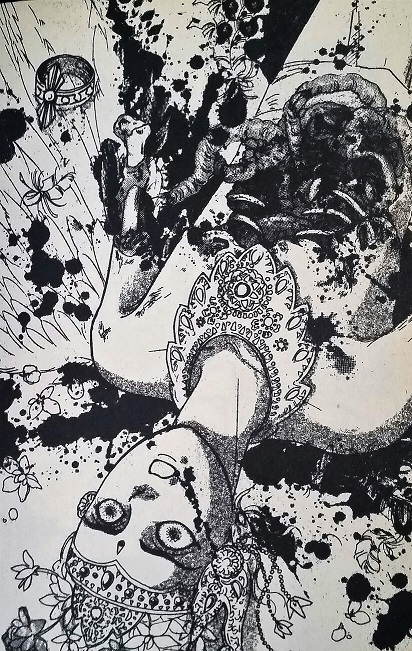
The series is unfortunately long out of print, and later volumes are hard to find. I imagine that it wasn’t a huge seller for Tokyopop, though I am forever grateful that they took a chance on it to begin with. The anime is available to stream on HiDive, brief as it is, if you’d like to get a glimpse into Count D’s enigmatic Chinatown pet shop.
February Favorites
Time for something new! I’m going to start trying to round up some of my favorite comic reads at the end of each month. These won’t necessarily be things that came out the month in question (though I do try to keep up when I can), but anything I’ve managed to get my hands on that I feel is worth a mention. I read a lot, so I’m going to have to figure out how to limit my choices, but hopefully with time will come clarity!
I will say, first off, that this has been an…interesting month. I still feel so new to the freelance writing world, but I do think that things are coming together nicely, and I’m getting to a point where I can start challenging myself with how much work I take on. I also lost my cat, Mia, on February 12th. She was quite old, and her decline was very rapid. While she was sick, I spent a good deal of my time attending to her; after her death, there was a lot of time where I was just too miserable to feel like I wanted to do much of anything, let alone read. Still, a visit to Comicopia did help lift my spirits considerably, and while I have to be a little bit more judicious in my purchases right now, I was able to bring home some good new material.
I am also about to spend five days with my family while James is away on business, which is why I’m getting this out before the true end of the month. I suspect I will be too busy doing things with my mom and trying to keep up with my writing work to read too many more comics. But I wanted to give this segment a try, anyway, so I’ve decided to work with what I’ve got.
So without further ado, my picks for the month!
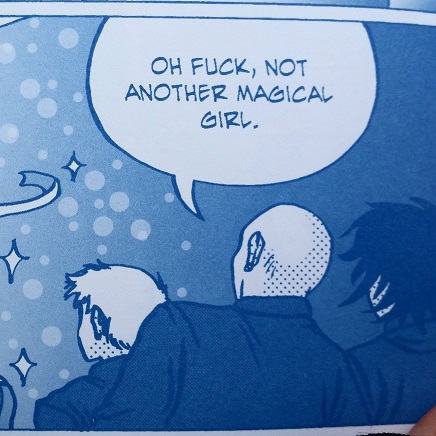
Magical Beatdown, Volume 1, by Jenn Woodall — published by Silver Sprocket
This slim little issue does one of my favorite things: It combines a love of the ultra-femme concept of the magical girl and mixes it generously with a hyper-violence that is both gross and cathartic at the same time. I think there’s a lot to be said about women enjoying and creating violent content, and some day I hope to talk about it more in-depth. But for now, I want to recommend the excellent pastel gore-fest revenge fantasy that is Magical Beatdown, because sometimes you just wanna go to the arcade without having to deal with losers! I’m looking forward to getting my hands on the second installment.

House of Penance, by Peter J. Tomasi, Ian Bertram, and Dave Stewart — published by Dark Horse Comics
Speaking of gore-fests, this standalone graphic novel is not for the faint of heart or stomach. The Winchester mansion in San Jose, California, is famous for it’s staircases that lead to nowhere, its doors that open onto nothing but air, and the nagging suspicion that it is not entirely empty. House of Penance is an exploration of Sarah Winchester’s mental state as she commissions the building of this strange domicile while grappling with the grief of losing her daughter and her husband, and the guilt of inheriting the wealth from a company whose business is murder. I’m always down for a strong anti-gun message, personally, and there is no holding back here as Sarah is confronted relentlessly by the victims of her in-laws’ firearm empire. Ian Bertram’s art is eerie and textured, Sarah especially portrayed with bug-like eyes that can see more than the men working around her. Dave Stewart’s incredible colors compliment Bertram’s lines beautifully, and his use of bright, vibrant blood red is very effective.
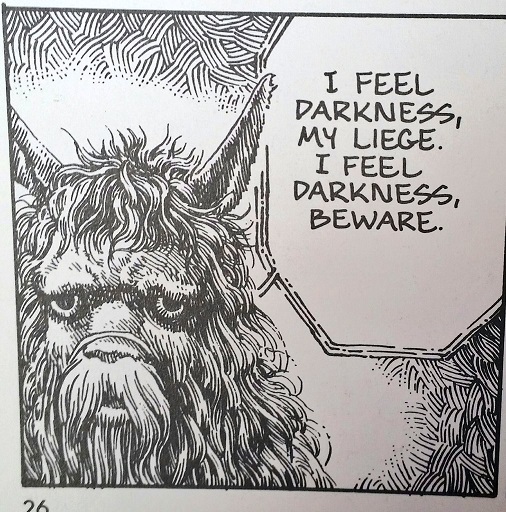
Shion: Blade of the Minstrel, by Yu Kinutani — published by VIZ Media (out of print)
I came upon this volume completely by accident, while I was still working at Comicopia. It was hidden away in storage, in a long box full of old single issue comics, many of which were single issue manga, from way back when everything was flipped and companies tried selling manga like Western single-issue comics. I was drawn to its striking cover and detailed artwork, so I brought it home. That had to have been nearly two years ago, as I had put it into a comic box and promptly forgotten it. I dug it out recently while I was doing some organizing, and I resolved to finally read it.
And honestly, I was stunned. This little volume is so extraordinarily different from any manga that is being licensed and published today. It wouldn’t be seen as marketable, probably, but I’m so glad that VIZ took a chance on it back in 1991, because it was a pleasure to read. The book is split into two stories that follow a mysterious minstrel who must first take his revenge on a monster who wronged him and his family, and then must take up a legendary sword to fulfill his destiny. That one sentence seems like straightforward fantasy, and in many ways that’s what Shion is; as an essay at the back of the volume explains, it is a classic hero arc seen in many fairy tales and epics. But it’s so gorgeously textured in its artwork, and for me it invoked the same feelings as Vampire Hunter D and classic Jim Henson works, especially The Dark Crystal. It’s creative and beautiful, and I’d love to see what Kinutani did after this work. Worth hunting down if you are able!

My Solo Exchange Diary, Volume 2, by Nagata Kabi — published by Seven Seas Entertainment
In many ways, there’s not much I can say that I haven’t said before, in various spaces, about Nagata Kabi’s autobiographical work. Of the three volumes she has out from Seven Seas right now, I think this one was my favorite, even though much of it was spent talking about her time in the hospital. I appreciate, more than ever, her honesty, especially as she realizes how her mental state had prevented her from understanding how much her family actually loves her and wants what’s best for her. She continues to struggle throughout the volume, but it is evident that she’s repairing her relationships and learning, slowly, how to better communicate her pain so that she’s not suffering alone. I know that many people have been critical of her constant self-destruction, but to that end I just have to say…it is evident those people have never struggled with serious mental illness, or really known anyone who has. What Kabi is going through is not logical, it is not easily navigated, and her honesty and willingness to expose herself like she this has surely had a positive effect on others who have felt similarly isolated, self-destructive, and hurt. I continue to send her only the kindest, gentlest, most positive thoughts as she works on overcoming her pain. It’s a hard road, and she’s been working at it for a long, long time. I hope she’s able to find some peace soon.
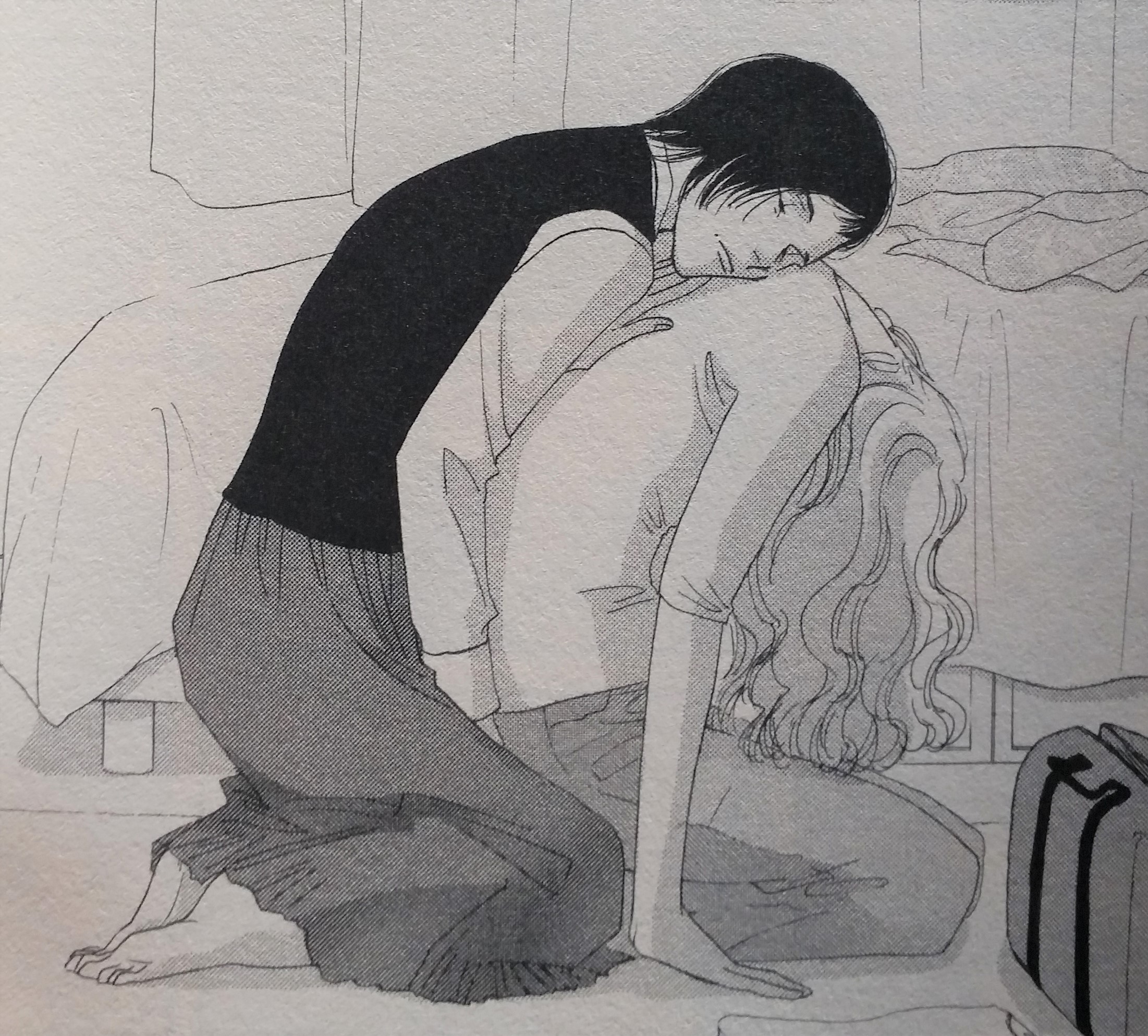
All My Darling Daughters, by Fumi Yoshinaga — published by VIZ Media
Fumi Yoshinaga is one of those creators whose work I always know I’ll enjoy, but who also manages to completely exceed my expectations every single time. So was the case with All My Darling Daughters, a standalone volume that explores various relationships between people in a friend group, with special emphasis on the one between Yukiko and her mother, Mari, who has married a much younger man. Yoshinaga has such a sensitive touch with her characters that I find myself sympathizing even with those who in a different author’s hands, I would absolutely hate. It is an incredible skill to express the nuances of humanity, and Yoshinaga is extraordinarily good at it. I felt especially drawn to the last story in the collection, which dives into Mari’s antagonistic relationship with her own mother (Yukiko’s grandmother). Mari hates her mother for having been unnecessarily cruel about her appearance while she was growing up, not realizing that her mother was trying, in her own imperfect way, to protect her daughter from becoming reliant on her good looks. I was so strongly reminded of the dynamics between the women in my own family, the dynamics between my mother and my grandmother, and the increased awareness I have lately of how heavy motherhood can be. “A mother is an imperfect woman,” Yukiko realizes, and it is a perfect underscore to a book full of imperfect people who are just trying to do the right thing.
Looking back, it seems I’ve read a lot of very different books this month, but there are certain themes that run throughout. A lot of introspection, explorations of mental health (both real and fictional), and a little bit of violence and some adventure to balance things out. I like the micro-review format because I can fit several recommendations into a post at once, and I am not liable to give too much away. I hope this proves useful, and I look forward to following up again next month with some more excellent reads!
My Favorite Reads of 2018
It’s that time of year again, where every single nerd news site tells you what the best-of-the-best comics of the year are. I’m always wary of trying to make blanket statements about literature, but I did want to share a few of my favorites from this past year. I’ve done a LOT of reading, and I feel as though I’ve branched out more than usual (or more like, there have been more titles in Western comics that have appealed to me than there have been in the past).
I didn’t give myself a limit to the number of books I chose, nor any kind of guideline as to theme, tone, etc. I just picked the ones I felt strongly about! These are listed in roughly the order I read them in, and by no means in order of quality. They’re all top-notch, anyway!
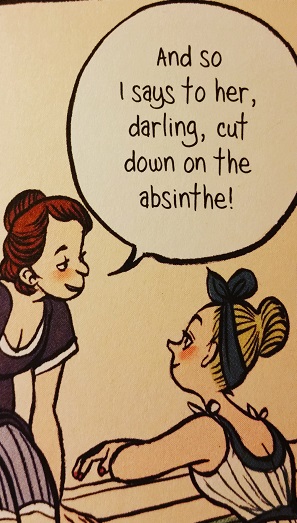
The Prince and the Dressmaker, by Jen Wang
Prince Sebastian has a BIG secret: sometimes he likes to wear dresses and go out on the town as Lady Crystallia. In addition to keeping this part of himself hidden from Parisian society, he has to deal with his parents determinedly seeking out a bride for him. Enter Frances, an extremely skilled seamstress with dreams of fashion design whom Sebastian employs to outfit him for all occasions, public and secret. The story of these two growing together and learning to be their best selves is captured incredibly in Wang’s bright, flowing artwork. Plenty of humor helps to balance out the heart-rending moments that remind the reader to never lose sight of the things that make them unique.
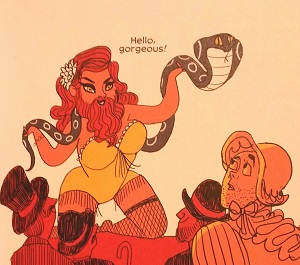
Brazen: Rebel Ladies Who Rocked the World, by Pénélope Bagieu
I genuinely did not expect to adore this book as much as I do. I’m not well-versed in the non-fiction graphic novel, and I’m often suspicious of cheery, pink-emblazoned “girl power” books — not because I don’t believe in girl power, but because it’s hard to encapsulate in one book what it is about womanhood that is so unique. That said, I was truly fascinated and enthralled by the stories that Bagieu, in her whimsical style, has presented in this hefty tome of awesome and awe-inspiring women. Women from all backgrounds, in all types of careers, with differing needs and goals, and with all sorts of romantic entanglements and personal dramas, are presented for the reader with reverence, joy, and good humor.
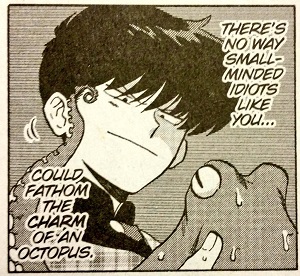
Go For It, Nakamura!, by Syundei
I have been seriously reveling in the increased publication of good, sweet, not-super-fetishistic BL manga this past year or so. In this exquisite example, young Nakamura knows for sure that he’s gay, and also knows for sure that he’s in love with his classmate, Hirose. The problem is, he doesn’t even know how to become friends with Hirose, never mind try to ask him out! Between caring for his pet octopus, perusing questionable BL for romance tips, and just generally trying not to act overly weird, will our stalwart hero ever secure Hirose’s friendship? A familiar story for anyone who was shy in high school, Go For It, Nakamura! uses awkwardness, hilarity, and genuine heart to create a sweet and fuzzy one-shot that will make you yearn for more. Syundei’s artwork is adorable, and very reminiscent of that of manga powerhouse Rumiko Takahashi.

Tokyo Tarareba Girls, by Akiko Higashimura
I wrote about my initial reaction to volume one of Akiko Higashimura’s forays into 30-something woman angst back when the print version first came out. The series is now three print volumes in (with all volumes available digitally), and it has not stopped being maybe the most anticipated title in my pull at work. Higashimura’s ability to poke fun at the stupidity of a woman’s society-bred anxieties while treating the same character with sympathy and understanding is so incredible to me. I often find it hard to articulate what it is that makes this series so good, because it’s really everything. Please…I don’t often make demands, but read Tokyo Tarareba Girls.
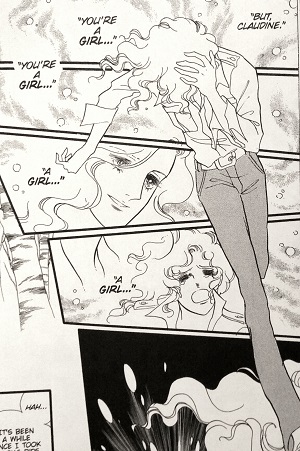
Claudine, by Riyoko Ikeda
I find this manga hard to recommend, even though I love it. It is a quick read; I read it from start to finish on my half-hour bus ride home from work one day. But it is also a dramatic and sad read, in true 70s shojo fashion. Our protagonist Claudine is assigned female at birth, but knows in his heart that he is a man. Even his own father embraces Claudine as more of a son than a daughter, going riding with him and treating him like his older brothers. Society in early 20th century France, however, is not as kind. To the rest of the world, Claudine is a girl, and the tragedy here lies in the outmoded concept that any woman he might love will never lead a fulfilled life with a “woman” partner. So in many ways, this is a fantastic achievement, being a trans story from 70s Japan; but it is also a story about a trans man from the perspective of a cisgender woman, writing at a time when shojo manga was about deep, dramatic personal struggles and utilizing queerness as a vehicle for those struggles. If you can go into it with the understanding that it is a sad story (and yes, I did cry on that fateful bus ride home), it is a simply gorgeous and heartbreaking work of tragedy.
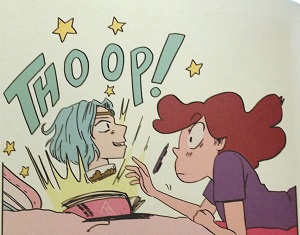
Making Friends, by Kristen Gudsnuk
I’ve been in love with Kristen Gudsnuk’s work ever since I read the first issue of Henchgirl, back when it was released by Scout Comics. Her artwork is fun, her dialogue is funny, and she makes plenty of obvious anime references that I feel are speaking directly to me and my sense of humor. So of course I was thrilled when Making Friends came out, and I was not disappointed. Protagonist Dany is starting middle school, where she is separated from her friends and everything that was familiar to her. She turns inward and begins to draw in the sketchbook she recently inherited from her recently deceased great-aunt. Soon she discovers that anything she draws in the sketchbook — including the head of her favorite anime badboy — comes to life! She quickly devises a plan to create a new, perfect best friend. But as we all know, magic has serious consequences, and Dany is going to have to figure out how to fix the mess she’s made. Gudsnuk does an excellent job of keeping this story about friendship and responsibility from becoming saccharine or tropey, instead treating every character with equal weight and relying on her uncanny knack for coming at a story from a slightly sideways perspective.
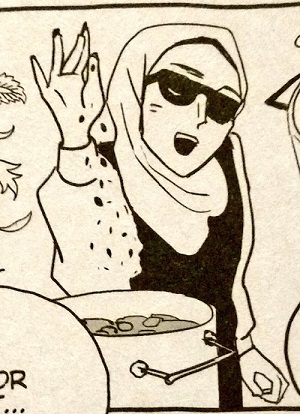
Satoko and Nada, by Yupechika and Marie Nishimori
This was absolutely one of my most anticipated titles of the year, and man oh man did it hit a home run for me. Upon initially receiving it I was uncertain, as it is laid out in 4-koma format, which I usually find cute but not particularly compelling. And yet in this easy gag style, with simple illustrations, Satoko and Nada manages to be a profoundly intimate story of friendship between women and across cultures. Nada is a college student from Saudi Arabia who is looking for a roommate. Satoko, a student in the same school, has recently arrived from Japan and chooses to become that needed roommate. Thus begins this tale of two people from very different backgrounds as they live together and learn all about each other and about their multicultural friends. Warm-hearted, informative, and full of meme references, this manga really surprised me in the best possible way. I want everyone to read it!
(Just an honorable mention here: I reread two of my absolute favorite series this year: Pet Shop of Horrors, by Matsuri Akino, and The Wallflower, by Tomoko Hayakawa. One day, I’d like to write at length about both of these series, but as they’re old and hard to find, I opted against adding them to this list. Look forward to an analysis of them one day, because I am very attached to them both!)
As you can see, I read a lot of very heartwarming stories by or about women this year. I have been immensely impressed by the range in stories and creators I’ve had access to, and that’s something I want to see continue to grow year by year. My reading list has been a bright spot in what has been a very tumultuous year otherwise (personally and in the world at large), and it gives me hope that more differing voices are being tapped to tell more and varied stories.
Looking forward to reading more in 2019!